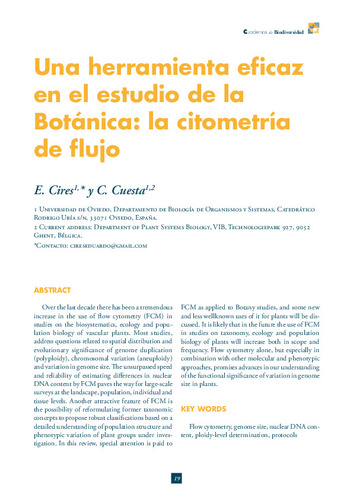An effective tool in the study of botany: flow cytometry
Otros títulos:
Una herramienta eficaz en el estudio de la Botánica: la citometría de flujo
Autor(es) y otros:
Palabra(s) clave:
Ecología
Flow cytometry
Genome size
Nuclear DNA content
Protocols
Fecha de publicación:
Editorial:
Universidad de Alicante. Centro Iberoamericano de la Biodiversidad (CIBIO)
Citación:
Descripción física:
Resumen:
Over the last decade there has been a tremendous increase in the use of flow cytometry (FCM) in studies on the biosystematics, ecology and population biology of vascular plants. Most studies, address questions related to spatial distribution and evolutionary significance of genome duplication (polyploidy), chromosomal variation (aneuploidy) and variation in genome size. The unsurpassed speed and reliability of estimating differences in nuclear DNA content by FCM paves the way for large-scale surveys at the landscape, population, individual and tissue levels. Another attractive feature of FCM is the possibility of reformulating former taxonomic concepts to propose robust classifications based on a detailed understanding of population structure and phenotypic variation of plant groups under investigation. In this review, special attention is paid to FCM as applied to Botany studies, and some new and less wellknown uses of it for plants will be discussed. It is likely that in the future the use of FCM in studies on taxonomy, ecology and population biology of plants will increase both in scope and frequency. Flow cytometry alone, but especially in combination with other molecular and phenotypic approaches, promises advances in our understanding of the functional significance of variation in genome size in plants.
Over the last decade there has been a tremendous increase in the use of flow cytometry (FCM) in studies on the biosystematics, ecology and population biology of vascular plants. Most studies, address questions related to spatial distribution and evolutionary significance of genome duplication (polyploidy), chromosomal variation (aneuploidy) and variation in genome size. The unsurpassed speed and reliability of estimating differences in nuclear DNA content by FCM paves the way for large-scale surveys at the landscape, population, individual and tissue levels. Another attractive feature of FCM is the possibility of reformulating former taxonomic concepts to propose robust classifications based on a detailed understanding of population structure and phenotypic variation of plant groups under investigation. In this review, special attention is paid to FCM as applied to Botany studies, and some new and less wellknown uses of it for plants will be discussed. It is likely that in the future the use of FCM in studies on taxonomy, ecology and population biology of plants will increase both in scope and frequency. Flow cytometry alone, but especially in combination with other molecular and phenotypic approaches, promises advances in our understanding of the functional significance of variation in genome size in plants.
Colecciones
- Artículos [37532]
- Biología de Organismos y Sistemas [770]
Ficheros en el ítem




